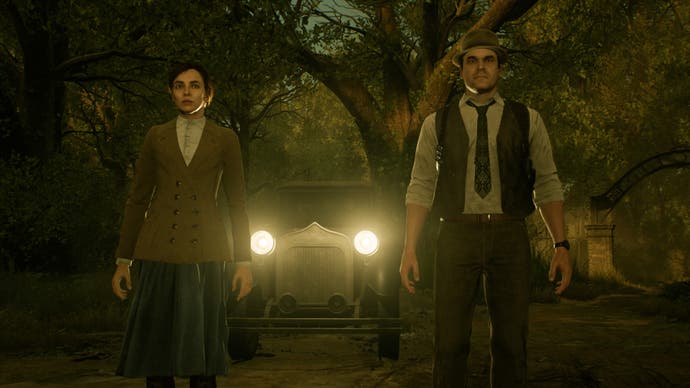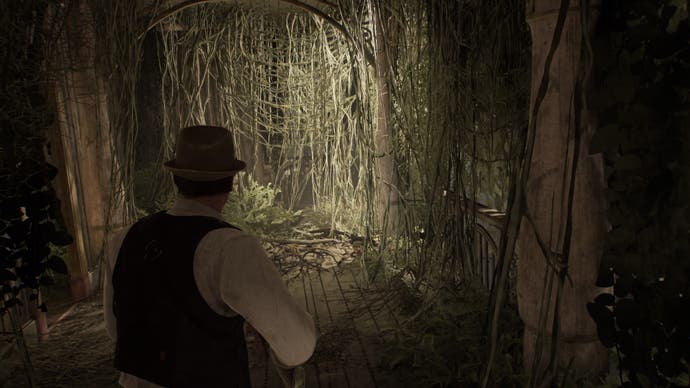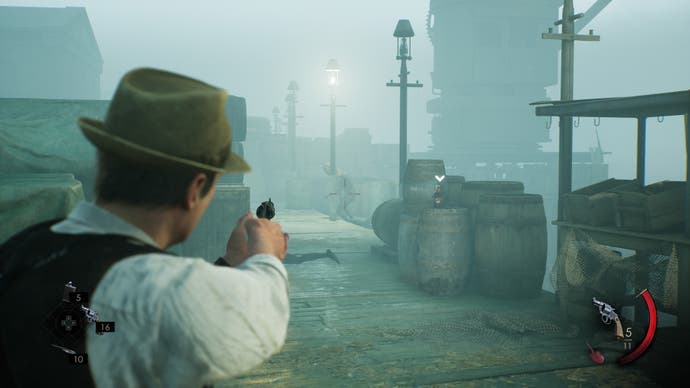Janky. That’s the word that springs to mind when I think back to the games I used to play – Alone in the Dark among them – as a kid. Along with the fixed camera angles and tank controls were the bugs and the glitches and all that lovely jank, as much a part of survival horror’s storied beginnings as Resident Evil’s “itchy tasty” memo.
Pisces Interactive’s reimagining of 1992’s Alone in the Dark adopts its inspiration’s dark story and even fixed cameras at times, but it also preserves – unintentionally, I suspect – the jank. In fact, there’s no part of this modern Alone in the Dark remake that’s jank-free – combat, puzzles, sound, script; you name it. For some, it’ll feel like an integral part of Alone in the Dark’s experience that’ll only add to its appeal. For others, it’ll be an instant turn-off. For me? For me, it’s somewhere in the middle, straddling a forgettable no-man’s-land of mediocrity that’s only saved, in part, by the reimagined storytelling.
Alone in the Dark’s story deviates a little from the 1992 original, but certainly not to its detriment. Just like the OG, you can choose to play as either PI Edward Carnby, voiced here by the magnificent David Harbour, or Emily Hartwood, who’s been brought to life by the equally magnificent Jodie Comer. However, the script is so stilted it’s hard for either performance to be memorable, let alone magnificent, and the performers are peculiarly… well, reserved. I know; I’m surprised, too, not least because both Harbour and Comer are fine actors who typically emit the kind of satisfying, larger-than-life energy that could’ve – should’ve – translated gloriously to a schlocky horror like Alone in the Dark.
 Let’s Play the Alone in the Dark Demo! Alone in the dark PS5 gameplay!
Let’s Play the Alone in the Dark Demo! Alone in the dark PS5 gameplay!
Emily has engaged Carnby’s services in her search for her erstwhile uncle Jeremy, and brought him to Decerto Manor, a dusty old house-cum-sanatorium hosting a motley of staff and patients. Developer Pisces says that whilst the two characters will share some story beats, the adventures will feel distinct and disparate thanks to separate scenarios, and you’ll have to play both to truly “complete” the game. My experience, however, is that whilst each of the characters’ individual “traumas” were undoubtedly the highlight of the game – I was especially moved by Emily’s – there’s disappointingly little to differentiate between Teddy and Emmy’s ordeal. Being charitable, it at least gives you another excuse to run through the 8-10 hour campaign; being cynical, it artificially bloats the completion time.
It’s always a bit of a gamble, giving voice to characters that have remained mute for a generation, but it’s kind of wonderful to get a sense of how Carnby and Emily feel as they fight their way through Decerto. And while there’s a little tweaking of the mansion’s layout, this, too, isn’t gratuitous; in fact, many of the original’s set pieces and colour schemes should feel familiar in this new version, too. Even the ominous sound of the door slamming shut behind you is a glorious callback to Alone in the Dark’s namesake.


And in a lot of ways, Alone in the Dark is the perfect game for reluctant horror fans. There are only a handful of jumpscares (the same one got me twice, once each playthrough), the enemies you encounter are weird, sure, but ultimately underwhelming, and slowly opening up the mansion – and the other places to which it sends you – is genuinely thrilling, especially when it goes full Haunted House mode, and the rooms switch and rearrange themselves when your back is turned. Throw in an added layer of sophisticated psychological horror with the individual storylines – the story has been penned by SOMA writer Mikael Hedberg, and it’s a good one, if a touch predictable – and there’s a lot here for horror-lite fans to get excited about.
The problem with Alone in the Dark is that, despite a stellar cast that does its best with an unremarkable script, there’s little here that feels polished. The sound – both music and SFX – glitched continually throughout my first PS5 playthrough with Carnby (admittedly not during my second time through with Emily, although that could have been because I’d applied an update between), and combat frustrates far more than it delights.
Even its puzzles – hitherto synonymous with the series – oscillate wildly from insultingly easy to mind-numbingly opaque. I hope you like tile puzzles, my friend, because there’s a metric poop-ton of the things here, and even if you do (and I really, really do!), brace yourself for fifteen minutes of frustration as many of the individual tile pieces can be rotated, too, and make as much sense upside down as they do right-side up.

And then, another time, you literally pick up a key item from one side of the screen, turn around, and pop it into a very obvious key-item-shaped indent about six inches away. That’s it. That’s the puzzle. Congratulations. Quick, download a MENSA application.
The collectible system, though? Oh, that is wonderful. Like most games, Alone in the Dark could’ve made you collect stuff for no reason other than we’re gamers and completionists who like collecting stuff, but the non-essential items you collect along the way – known in-game as Lagniappes, or small gifts – are delightful. Each time you complete a set, you’ll be rewarded with “forbidden knowledge”, such as an extra insight into the game’s lore, or – my favourite – access to a shotgun cabinet. And you’ll only get to complete the set if you indulge both Carnby and Hartwood’s scenarios.
But it’s… well, yes, janky. I very genuinely lost count of the number of times I had to reboot because Carnby got stuck on a tiny piece of furniture or because – for reasons still unexplained – the camera pulled tight on Carnby’s face and it was impossible to see anything, let alone win a fight. Talking of which… look, we all know that, despite its “survival horror” packaging, the original Alone in the Dark didn’t sport the greatest combat, so I wasn’t expecting Carnby to combat roll around the place or anything. But it would be nice if there wasn’t an input delay when asking either character to swing a weapon or fire a shot, especially when you’re running around in close quarters. This didn’t happen just once or twice, either; it was a continual issue that plagued me from my very first fight to the very final boss encounter.


The only upside is that this unscripted pacifist mode does make each tedious enemy encounter just that little extra spicy.
Whilst the combat was equally annoying in both scenarios, it does feel as though the patch I applied between my playthrough as Carnby and Emily mitigated some – if not quite all – of the glitches I experienced. In my original draft, I’d noted that the degradable weapons – whilst not necessarily a crime in and of itself – were particularly irritating because, with no health metre on them, there was no way to know how long they’d last until they literally splintered in your hands. Since the update, however, a teeny little warning sign has been appended to your HUD, which thankfully ameliorates this unnecessary frustration.
So much of Alone in the Dark’s thoughtful design is lost in the execution, though. There’s a fantastic Resident Evil 4-esque map that not only depicts where you have and haven’t been yet, but also shows if you’ve missed any items, found a key to a previously locked door, or uncovered a clue that means you can now complete a puzzle that was previously off limits to you. But you can’t zoom in to read the tiny print, which means it’s useless to anyone besides those of you who play three inches away from your screen. Similarly, you’ll often exit a cut-scene with your torch inexplicably turned off – Why, Ed? Why can’t you just leave it on, like I asked you to? – and the throwables are essentially useless, given you can’t store them, and if you want to hold onto one, the characters slow to a crawl and the camera zooms in, making it incredibly difficult to see anything.

None of these things are hangable offences on their own, no. But put them together, and you’ll spend more time fighting the game itself than any of its creatures.
To its credit, Alone in the Dark has a forgiving save system, though, which means even if you encounter the same zoom and stuck-on-the-environment issues as I did, you can at least save and reboot without losing too much progress. The one outlier is the final boss encounter, during which there’s no autosave or manual saving even between phases, so if the camera does its zoomy thing in the last section – which it did for me, three bloody times – you have to start over.
What is clear is Pisces’ palpable love for the source material. Not only do certain areas of Derceto boast the same furniture and colours as the original game, but we’re treated to a joyous little throwback near the end of the adventure that will feel instantly familiar to anyone who remembers survival horror the first time around. But it’s not enough. Curious collectibles and an obvious adoration for the original games aside, Alone in the Dark is too glitchy, too tedious, and too unpolished in ways that genuinely detract from the stunning set designs and Hollywood cast. It’s not that Alone in the Dark needs to be all singing and all dancing – it doesn’t have to have stellar gunplay and terrifying creature design or challenging puzzles – but if you’re putting all those things into a game, they at least need to work. They need to feel robust and meaningful. You shouldn’t have to dread seeing an enemy in the distance, not because you’re scared, but because you’re never sure if Carnby’s inability to shoot is going to get you killed this time.
And if a puzzle-heavy action horror game has repetitive puzzles, poor combat, and little-to-no horror… well, what’s left? Sadly, not even a Hollywood cast is enough to gloss over Alone in the Dark’s considerable flaws.
A copy of Alone in the Dark was provided for review by Pieces Interactive.

